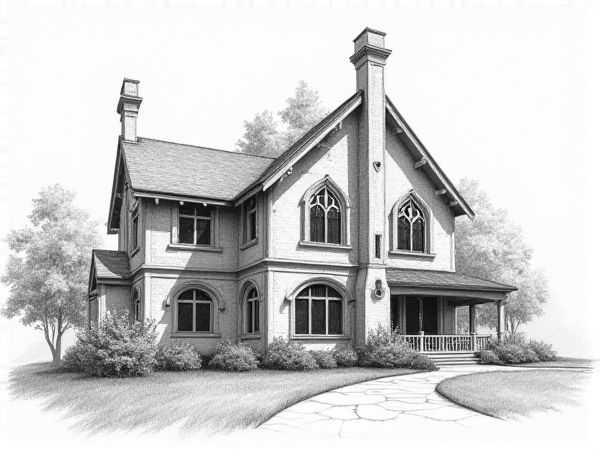
Photo illustration: Gothic Revival home design with lancet arch windows
Gothic Revival home design showcases dramatic lancet arch windows that add verticality and intricate detail to your living space, creating a timeless, elegant atmosphere. Discover the history and unique features of this architectural style by reading more in the article.
Introduction to Gothic Revival Home Design
Gothic Revival home design features pointed arches, steep gables, and intricate wooden trim that evoke medieval European architecture. Your space embraces dramatic vertical lines and ornate details, creating a timeless and elegant atmosphere.
Historical Origins of the Gothic Revival Style
The Gothic Revival style emerged in the late 18th century as a reaction against the classical architecture dominating Europe, drawing inspiration from medieval Gothic cathedrals and castles. Rooted in England, architects like Augustus Pugin championed the style, emphasizing pointed arches, intricate tracery, and vertical lines symbolic of medieval spirituality and craftsmanship. This architectural movement spread across Europe and North America during the 19th century, influencing churches, universities, and residential buildings with its romanticized medieval aesthetic.
Defining Features of Gothic Revival Architecture
Gothic Revival architecture is characterized by pointed arches, steeply pitched roofs, and intricate tracery on windows, which create a dramatic and vertical emphasis in home design. Ornate details such as finials, buttresses, and decorative patterns in stone or wood further enhance the historic and romantic aesthetic typical of this style.
The Significance of Lancet Arch Windows
Lancet arch windows enhance your home's aesthetic by introducing vertical elegance and historical Gothic charm, increasing natural light while maintaining structural integrity. These tall, narrow windows optimize space utilization and complement various architectural styles, adding unique character and boosting property value.
Material Choices for Gothic Revival Homes
Selecting authentic materials like limestone, dark-stained wood, and wrought iron enhances the intricate details of Gothic Revival homes, emphasizing pointed arches and ornate tracery. Your commitment to these historically accurate elements ensures the timeless elegance and structural integrity synonymous with Gothic Revival architecture.
Color Schemes and Textural Elements
In home design, carefully selected color schemes create mood and spatial perception while harmonizing with natural light to enhance aesthetic appeal. Incorporating diverse textural elements such as smooth woods, rough linens, and glossy ceramics adds depth and tactile interest, making interiors more dynamic and inviting. Balancing warm and cool tones with varied textures ensures a cohesive yet stimulating environment that reflects personal style and comfort.
Integrating Lancet Arch Windows in Modern Homes
Lancet arch windows introduce a distinctive Gothic-inspired aesthetic that enhances natural light and architectural elegance in modern home designs. Incorporating energy-efficient glazing and minimalist framing ensures these windows complement contemporary styles while maintaining functional performance and sustainability.
Interior Design Elements Inspired by Gothic Revival
Interior design elements inspired by Gothic Revival prominently feature pointed arches, intricate tracery, and rich wood paneling that evoke a sense of medieval grandeur. Dark, moody color palettes combined with ornate furnishings, such as carved chairs and heavy drapery, emphasize the dramatic and romantic ambiance. Stained glass windows and wrought iron chandeliers add authentic Gothic character, enhancing the historical and architectural depth of modern interiors.
Landscaping Ideas for Gothic Revival Exteriors
Incorporate wrought iron fencing and sculpted topiary to complement the intricate details of Gothic Revival exteriors, enhancing the historic ambiance. Utilize dark, textured stone pathways paired with lush greenery such as boxwoods and ivy to create a dramatic contrast that highlights pointed arches and ornate tracery. Soft uplighting on gargoyle statues and spired finials emphasizes architectural features, establishing a mysterious yet elegant outdoor space.
Tips for Restoring and Maintaining Gothic Revival Houses
Preserve the intricate woodwork and stained glass windows by using gentle cleaning agents and avoiding harsh chemicals that can damage historical materials. You should regularly inspect the roof and masonry for cracks or water damage to prevent structural issues common in Gothic Revival houses.
 homedesy.com
homedesy.com